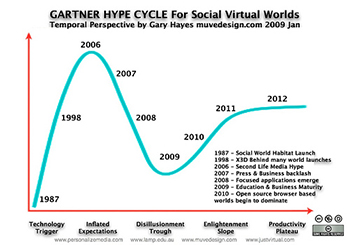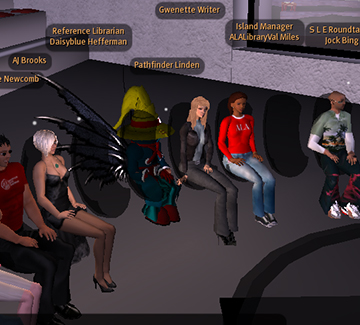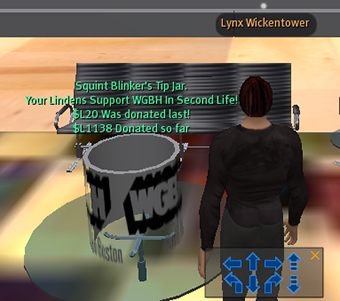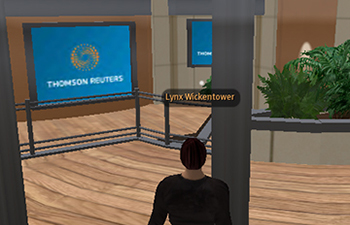
The sun shines brightly as I stroll along the curving pier above the water, looking out toward a beautiful island with trees swaying in the wind. There’s a looming ampitheater festooned with signs for Thomson Reuters, and a series of concrete buildings that appear ready to hold important meetings. I stride in confidently through the doorway…
You might think I was describing a trip to visit Reuters in the UK, but really, I was strolling through the virtual world of Second Life (SL), visiting the Thomson Reuters island, now largely vacant. The island symbolizes the efforts of media companies not only to cover life in the virtual world of Second Life, but also to live there and set up virtual offices. Reuters made waves by setting up a bureau in SL, with reporters Adam Pasick and Eric Krangel covering stories about the virtual currency and the startup businesses springing up in-world.
But last October, Reuters closed its bureau, and let its specialized blog lapse. CNET and Wired also developed land in Second Life and both have largely abandoned their efforts (though CNET Japan still has an outpost). CNET’s Daniel Terdiman, who helped shepherd CNET’s presence in SL, still writes about virtual worlds on his blog, Geek Gestalt, but hasn’t written specifically about SLfor a year. CNN, however, came later to SL, in late 2007 with its iReport presence, which recently was beefed up to an island where SL users report on their own world as citizen journalists.
How did the media go wrong in coverage — and participation — in SSL, and what went right? It was a typical hype-and-backlash scenario, as I detailed in a previous post on MediaShift. Some journalists simply tired of SL, as so many people tried it and then bailed because of its steep learning curve and high technological requirements. But the journalists that have been more enmeshed within the world have been rewarded with plenty of cultural and sociological (and yes, business) stories.

“Unless you consider coverage of any kind as constituting breathlessness, I’m not sure the overall coverage was too breathless [back in 2006],” said Rob Hof, Silicon Valley bureau chief of BusinessWeek, who penned a major cover story about SL. “It was just voluminous for awhile there, probably a little too positive at the outset and then, for some good reasons, more negative later…As you know, this kind of cycle is endemic to journalism, for better or worse: Build ‘em up, tear ‘em down.”
John Lester leads customer market development for education and health care for Linden Lab, which runs Second Life. I met him in-world and had an instant-messaging chat with his alter-ego, Pathfinder Linden, about how the media has covered SL over the years. My SL name was Lynx Wickentower:
Lynx: Did media miss the bigger story of Second Life?

Pathfinder: That seems to be a typical pattern for the human species, yes? We did it with all the previous mediums. We’ll do it again in the future. We always misunderstand new mediums, initially treating them like pre-existing ones (e.g., treating the web like print media; treating television like radio). But then we learn new ways of seeing the tools and new ways to leverage them.
About-Face from Wired, Reuters
What’s especially striking is how some previous boosters of Second Life have turned against the virtual world. I was a guest on NPR’s “Talk of the Nation” back in 2006 with Reuters’ SL bureau chief Adam Pasick. On the show, Pasick was almost like a representative for Linden, explaining SL to the public in great detail. “Just about every business you can find in the real world is now in Second Life,” he said on the show. The Reuters island still includes basic instructions for moving around SL, and the wire service basically picked a favorite by choosing to have a bureau in SL and not simply having a correspondent covering all virtual worlds.
Now, Pasick told me via email that Second Life will now be covered within the existing technology beat by Reuters.
“We were primarily interested in Second Life as a business/commerce/finance phenomenon, covering it like we would any small but fast-growing economy in the real world,” Pasick said. “The bureau is now closed. Essentially the story we were there to cover has moved on. Second Life continues to be an interesting and popular virtual world, albeit one that is growing much more slowly than during its heyday. Our technology team continues to cover Second Life and Linden Lab, and we still have our island in Second Life, which we may use for corporate functions at the Thomson Reuters level.”
The other Reuters reporter who covered SL, Eric Krangel, had an even stronger change of heart. In February 2008, Krangel participated in a virtual talk show about media companies in-world, and had this to say about SL and Reuters’ participation:
Part of the reason I’m here personally is because I find Second Life absolutely fascinating. And I think no one anticipated, and it’s not just my interest, but also Reuters’ interest, is how complex of a creation Second Life has become…Reuters reaches out to the 1.2 million people who are in Second Life every 60 days. It is a tremendous amount of press that Reuters is getting. A lot of knowledge of people who are understanding what Reuters is, what Reuters does, who perhaps wouldn’t otherwise have that. So really, I mean I think they’re extending their brand in a way on a very little expenditure that I think perhaps other organizations might follow suit.
Once Reuters killed its SL bureau, Krangel joined Silicon Alley Insider and was quick to criticize SL’s shortcomings:
It’s hard to say what, if anything, Linden Lab can do to make Second Life appeal to a general audience. The very things that most appeal to Second Life’s hardcore enthusiasts are either boring or creepy for most people: Spending hundreds of hours of effort to make insignificant amounts of money selling virtual clothes, experimenting with changing your gender or species, getting into random conversations with strangers from around the world, or having pseudo-nonymous sex (and let’s not kid ourselves, sex is a huge draw into Second Life). As part of walking my ‘beat,’ I’d get invited by sources to virtual nightclubs, where I’d right-click the dancefloor to send my avatar gyrating as I sat at home at my computer. It was about as fun as watching paint dry.

As for Reuters’ coverage of SL, they did better than most journalists who did drive-by stories with a day or two of research in-world. The bureau lived for more than two years. Still, James Wagner Au, who writes the excellent New World Notes blog about SL said they could have done better.
“Their writers, Adam Pasick and Eric Krangel, are fine journalists, and did some great external business-oriented reports, but at the same time, I don’t think they were ever passionately engaged in the medium or Second Life’s community on an experiential level,” Au told me. “Consequently, their reporting very much had a distanced, ‘outside looking in’ flavor that caused them to often miss the big picture, in my opinion.”
Wired magazine followed a similar pattern, creating an island in SL and running a special travel guide in the magazine that was nominated for a National Magazine Award. But less than two years later, the magazine’s editor, Chris Anderson, said he was giving up on Second Life on his Long Tail blog:
Well, partly it was the whole ‘there’s nobody there’ problem, which is of course just anecdotal. Like everyone else, I had fun exploring the concept and marveling at all the creativity. Then I got bored, and I started marveling at something else: all the empty corporate edifices. By day I’d speak at marketing conferences that usually had someone pitching SL services, complete with staged demonstrations (the ‘inhabitants’ invariably paid employees). By night I’d go back to the same places, which had reverted to ghost towns once the demonstration was over. I couldn’t understand why companies kept throwing money at in-world presences. Were they seeing something I wasn’t?
When I recently contacted Anderson for this story, his response was terse: “I don’t really follow SL so I can’t comment…I thought SL was fascinating and was glad to have participated, not least for the learning.” One SL resident, going by the name of Bettina Tizzy, was non-plussed by Wired’s efforts in Second Life, and explained on her blog how Wired’s pullout from the world had a domino effect for businesses:
Therein lies the problem that not only Wired magazine, but pretty much every single Real Life corporation that I know of (except Pocky!) has experienced to date as they fiddle around with their Titans-in-pixelated-cubicles (and we’ll give you a free baseball cap and T-shirt, too!) approach. Not surprisingly, nine months after their launch in Second Life, Chris Anderson, Wired’s editor-in-chief, and his minions were slamming the metaverse, and jumping ship. And like a house of cards, Real World corporations began to flee, one after another.
What Went Right
While Reuters thinks that the story has moved on from Second Life, CNN and many others beg to differ. The broadcaster now has an even larger presence in SL. Rather than send in a reporter as a corresponent in-world, CNN relies on SL residents to report their own news as citizen journalists for its iReport site.
CNN.com senior producer Lila King said that Second Life iReporters have posted 376 stories since it launched a year ago, but that relatively small number did lead to a number of stories on written by CNN.com producers (including this one about relationships in-world). King said that SL has been more than just a story-generating tool for CNN’s iReport team; it’s also helped them learn to nurture an online community.
“We’ve started to see a new benefit of being in Second Life: it gives us a place to polish our skills in community building,” King said. “Newsrooms everywhere, ours included, are trying to learn how to foster meaningful, two-way conversations with their audiences. When we hold our virtual news meetings every Tuesday afternoon (2 pm Second Life Time/5 pm ET) with the Second Life iReport community, that’s exactly what we’re doing: listening and interacting in real-time, offering feedback and courting new ideas along the way.”
Au points out that the media still is covering Second Life, and that there have been “more than several dozen articles on it this year,” including less sensationalistic stories that look at the important cultural happenings in-world.
“Prominent media reports still happen, though…they’re generally less hyperbolic, less about one-off marketing campaigns, and much less ‘OMFG this is the next generation of the Internet!’” he said. “Instead there’s more focus on the world’s creative ecology that’s happening right now.”

Public media outlet WGBH in Boston produced a live classical concert in Second Life last May, with pianist Jeremy Denk performing in the real-world radio studios, which went on-air and also was attended in a virtual space online. Mike Janssen, who writes for the classical radio blog, Scanning the Dial, said that WGBH got a good reaction from the 70 people who attended the event in-world, but wasn’t sure how to quantify the success of the experiment.
“I’m trying to make the argument that it’s really the quality of the experience that, in the long run, is maybe more beneficial than the fact that 100,000 people saw a program,” WGBH producer Gary Mott told Janssen. “The usual metrics that we measure audience by didn’t seem to apply here.”
Perhaps not, but WGBH received a $12,000 grant from the Corporation for Public Broadcasting to try out the live in-world performance. Mott told me in a recent email exchange that WGBH’s SL experiment was in limbo at the moment, and that they didn’t receive more funding from the CPB though they are hoping to find a partner in Linden or an educational institution in Boston. One great product of the experiment is a report Mott wrote (PDF file) about his lessons learned in SL
Janssen, for one, thinks that it might be a tough sell in public broadcasting.
“I think it makes sense for broadcasters to be experimenting on all platforms to some extent,” he told me. “But realistically, and with money as tight as it is these days, they have to make serious choices and should avoid spreading themselves too thin. SL has a ‘wow’ factor to it, but at the moment probably isn’t a top priority.”
One thing that has survived the hype is the virtual economy of Second Life and other online worlds and gaming environments, where people sell virtual goods with game-based money that can be converted to real money. BusinessWeek’s Hof believes that’s a story that has staying power.
“The notion of virtual economies is already becoming a solid business model for many game companies, and even social networks like Facebook — by some accounts up to $2 billion in revenues — so that seems like a trend that has some legs, and it’s one you can credit Second Life with proving as much as anyone,” Hof said. “And of course, the idea of user-generated content is huge today on a number of fronts, though Second Life is just one example of that.”
Education and Collaboration
While the effusive media coverage might be long-gone, Second Life is evolving into a practical platform for some educational and business purposes. Joe Essid writes the SL Beat blog for the Richmond Time-Dispatch, and he also is director of the University of Richmond’s Writing Center. Essid told me that now that Second Life has matured (it was first launched in 2003), it has found some practical uses but they aren’t as sensational as virtual sex and nude avatars.
“SL and other virtual worlds are making gradual progress toward regular usage by higher education and business customers,” Essid said via email. “Stability and the quality of ‘life’ in SL have improved, though not without a great deal of controversy over fees and policies from Linden Lab. But day-to-day use of the Internet is not ‘sexy’ stuff: it’s just how we do work. And to me that’s fine, since SL is another tool for teaching, albeit one that inspires some amazing creativity and can be a lot of fun to use.”
Essid tipped me off to an in-world meeting of librarians and educators who were sharing tips for using SL in education. I could see how such a discussion — this one was just people texting as in a live chat forum — could be productive, as I made connections through private instant messaging to particular participants as the discussion continued. I could view people’s profiles and see who they were in the real world.

Lawrence Mullen, a journalism professor at the University of Nevada, Las Vegas, is taking his students into Second Life so they can experiment in-world.
“There are a number of virtual magazines in SL — they come and go — but there are many new projects always starting,” he told me. “And maybe it’s good that the large media corporations aren’t getting into SL — thus giving others a chance to redefine what journalism is or should be. I designed a course that explores the virtual world more from a sociological/anthropological perspective than a journalistic way. Students design their avatars, learn how to use them, them I give them missions to explore aspects of the media used in the virtual world, but also religion, various communities, building, relationships, advertising, and more.”
In the current economic recession, with businesses rethinking the way they spend money marketing online, including in virtual worlds, Linden hopes that Second Life can be seen as a place businesses can save money with virtual teleconferences.
“Virtual worlds are particularly poised to save a lot of money [for businesses] around new modes of collaboration and meetings,” Linden’s Lester told me. “Nobody has budgets to fly around in planes and stay in hotels anymore. I think businesses, given the current economic climate, are eagerly seeking better ways to collaborate at a distance and manage a global presence in a more cost effective way. SL is more than a teleconferencing medium. It has synchronous collaboration opportunities. Lots more emotional bandwidth, too.”
What do you think? Did media companies turn their backs too soon on Second Life? Are there still important stories happening there? Where do you go for media coverage of SL? Share your thoughts in the comments below.
Second Life hype cycle image by MUVEDesign’s Gary Hayes via Flickr.


This is a thought provoking article. RL Media indeed pulled out too fast, either they don’t understand, or they don’t know where or how to start. Being in this world will force you to think of new ways to “do” media.
I’ve been writing about SL for a year now, and I think that Mr. Mullen’s observations about SL publication is spot on. Also, CNN’s strategy seems better suited for the VW’s community-centered atmosphere. I’ve always loved the concept of i-report and thought that this would work in SL.
Good article and I agree that while the large corporates are leaving, eductaion and training are starting to take off. We have found the SL platform to be an effective and fun way to offer continuing education for CPAs and info for accounitng students and educators.
Thanks for the post Mark and link to my flickr site – readers might be interested in a similar article I wrote (hence the hype curve) some time ago at MUVEDesign and one entitled ‘ROI and the Stickiness of Second Life’ on my top 200 marketing blog personalizemedia.
Best Gary
Last time Iooked (2-3 weeks ago?) the sim was still there even if (like most places ) it is unstaffed. There is also a (more interesting) Thomson Reuters sim. I never found Reuters an especially good source of low-grade info though they got the occasional big story. They were, however, the source of a nice branded inworld RSS viewer which certainly made me think more positively about the company at the time.
Interesting piece, and an odd quirk at the end that ties back to Pathfinder’s comment.
If you’re going to stream a concert to an island you’re currently limited to 80 or so ticket holders. Whilst there is some appeal to virtually attending the concert, just like really attending the concert, providing a streaming source so people can listen ‘at home” in Second Life might get much larger audience numbers for no cost – and assuming that advertising is paying for the concert’s transmission, you’d get the advertising out there too.
Add in a good low-cost/free concert venue pack so people can build their own concert halls if they choose and you might just have a winner.
Sounds remarkably like thinking about the medium in a new way might help them along in ways they can recognise, analyse and possibly sell on to others.
Piggybacking on what Eloise and Mark said:
I found SL through that NPR broadcast in 2006 and figured if the Big Boys were doing it, I could too. I joined up and found SL was SOOO much more than an advertising media, and I think that’s something all those big companies missed. Case in point: the concerts.
There are hundreds of concerts given in SL every week by artists from around the world. And they don’t spend huge amounts of money, either. These artists are making RL livings from the fees and tips they get — while building up an audience who then goes out to buy their RL CD’s.
But as noted in your post, Mark, these efforts are not “sexy” either. So my inworld readings of my RL books, the incredible work of the writer’s communities, the talent of the musicians and the hard work of the educators are overlooked in the rush to dismiss Second Life as a viable entity simply because we’re not Big Boys.
Good post! Thank you :)
I just don’t get it
I passed on SL and glad I did
Good to know it was a fad…
Good instincts Heh?
Eloise & Diana,
Thanks for the great comments. I agree that live music seems to be a great way for artists to gain recognition (and revenues) in Second Life, and I’ve heard that from other sources as well. While it may not be the big-name artists such as Ben Folds from 2006, if these artists can build a following, even a small one, it’s a start. Could be a good topic for a future post at MediaShift.
Glad you all enjoyed the post and topic — it’s good to follow-up on topics I’ve covered before, and this time actually go in-world!
One of the challenges of writing about the Second Life virtual world is that its audience is relatively small. At any one time, there may be between 50,000 and 70,000 people online, which is not huge. And the figures touted for number of accounts (such as 12 million) doesn’t mean those accounts are being used. As has often been pointed out, these include “alts” (multiple avatars from the same real life person) and “bot” (avatar shells created by people to increase the popularity score of a location).
So any SL press activity has an inherently small audience; much smaller than a real life organization such as Reuters or CNN. Paying someone full-time to report on the happenings of a small world is difficult to justify.
Add to this the fact that just as in real life, many things are just boring and mundane, and you see how tricky it is to maintain a press presence.
And for those who are curious; yes, I do write for several SL publications, and no, the pay does not allow me to quit my day job ;)
“I agree that live music seems to be a great way for artists to gain recognition (and revenues) in Second Life, and I’ve heard that from other sources as well.”
As a live musician/producer with extensive experience in SL (and mixed reality events) it’s more than just recognition and revenues. It’s an independent musician’s working prototype of the new music paradigm for developing sustainable artist/fan relationships, connecting with “true” fans one by one for the long haul musical journey.
One mistake many people make with SL is thinking the 40-80 people you can currently squeeze into a sim is a serious limitation for this, and the only way forward is to scale as fast as possible so they can replicate the stadium entertainment model and play to 1000’s of avatars while tapping the rich vein of madison avenue.
A valid goal in itself, but it misses some of the key strengths of emerging platforms such as this, and is also why so many early corporate efforts failed.
Intimacy. Engagement. Communication. High Tech, High Touch in the words of John Naisbitt.
kt
the hype problem was not because of “positive” journalism on second life. it was problem because of “mindless” journalism about second life. its like every other tech journalist who wanted an easy story jumped on the bandwagon without really thinking about what they were saying and looking second life in the face for what it was. there were also social commentators who loved to use second life as a jumping off point for discussing culture or society/groups and all that speculative nonsense which had nothing to do with second lifes barren reality.
they didn’t ask the basic question. were the numbers on second lifes population correct.
they didn’t at all.
http://news.cnet.com/Counting-the-real-Second-Life-population/2100-1043_3-6146943.html
http://many.corante.com/archives/2006/12/26/lindens_second_life_numbers_and_the_presss_desire_to_believe.php
long after online publications started getting skeptical about the numbers mainstream media continued their spree of mindless second life stories.
second they never tested or asked if the second life solution for problems was superior or even equal to other online equivalents. did they try shopping on second life? was it really in any way better than using amazon? its so basic, yet it was glossed over for fluff. second lifes so called solutions for every problem was inferior. crude graphics, lack of any real control make the idea of virtual classrooms a totally ridiculous exercise in pointlessness. a simple whiteboard and streaming lecture/chat sessions would do for such things. social interaction? facebook/myspace/blogs/internet forums all provide superior solutions to second life. if google were done second life style you’d spend your time walking/flying from place to place to do simple searches:P
and for interaction with the population. you are playing interactive barbie with other disingenuous false faced people. thats the kind of environment that breeds nothing good. its just creepy. and the only real use is clear..virtual sex..and even thats crude and unimpressive and just downright sad.
as for business and schools using second life. as i said already, pointless and inferior solution to any problems presented. live chat/streaming/im/social websites/normal websites do the job of second life and then some without the rest of the frivolous nonsense getting in the way.
bottom line is that second life is a inferior solution to any problem you come up with.
forgot to add this one.
“How Madison Avenue Is Wasting Millions on a Deserted Second Life”
http://www.wired.com/techbiz/media/magazine/15-08/ff_sheep
one of the few mainstream publications to wake up about this relatively early on.
I’m glad Wagner James Au’s input was included here, because he is absolutely correct.
Anyone IN Second Life, living Second Life, knows to get their news from reliable news sources.
Reuters may be a top dog in the real world, but as for covering Second Life, they were just a 2nd rate news media source with two friendly, but uninterested reporters. Reuters bought a fancy overpriced office, and expected something, and received something else. The news (important real life business news inside of Second Life) is ALWAYS PRESENT!
The people of Second Life know where to get their news.
Thank you for this helpful overview.
As long as people view things that are game-like as trivial, and view virtual worlds happenings as pale imitations to the real (and not real in and of themselves), the use of virtual worlds for education or business won’t tip.
There has been progress since “Second Life” entered the vernacular, but clearly this shift couldn’t occur fast enough for the patience of most media enterprises. But I predict they will be back.
For me as a journalist Second Life is a very interesting experience because it helps me to learn about virtual communities. I am a member of the Metanomics show (http://www.metanomics.net) which also happens to be a vibrant community in second life, and I try to apply my experiences in facilitating the community of our newspaper.
This being said, it remains difficult or impossible to gather huge crowds in Second Life. For now, it works very well as a place for smaller gatherings and for serendipitous encounters.
Very interesting article. Whilst I can very well see the benefits that experientially and theoretically can be extracted from creating a Second Life presence, I completely agree with Wired and Reuters’ decision to pull out. Take into consideration where you are actually adding any value in comparison to technological predecessors and competitors. Second Life is not dead, however our appreciation for the novelty certainly is and I think a large degree of activity was previously based on this. Linden Labs need a new USP, as personally, I feel there is little in SL that cannot be achieved with greater ease and greater accessibility elsewhere online.
Maybe SL’s been overly commercialised too? Instead of focusing on building thriving social interactions where you can THEN monetize communities (a la Facebook and probably Twitter soon enough), too many companies billboarded the virtual world before the zeitgeist even reached there. Maybe they kinda shot themselves in the foot by venturing down the whole “business angle” route?
Great article, Mark, about SL as an evolving phenomenon. WGBH hosting a live music event in SL for 70 avatars (see Eloise’s post) is not newsworthy, itself. As has been mentioned in other posts, lots of folks frequently perform live in SL. The interesting thing about the Jeremy Denk perf is that it was also broadcast on the radio, in and around Boston, and following the performance, Jeremy fielded questions from the SL audience, and responded on mic. That’s a level of interactivity I only wish we’re available to the thousands in the broadcast audience!
Public Media should stay conversant with the language of SL – because I think it has a lot to teach about audience behavior and engagement. Something on the minds of every producer/programmer!
Thanks for the post Mark .
I think this was a good, fairly unbiased article on a critical view of Second Life. There is just a slight note I should add. In the “hype days” we were waiting to see the Fortune 100 all making an appearance in SL, since those catchy companies are the ones that get media coverage — thus the need for Reuters to be around.
It’s now 2009. SL has entered the “mature” stage where new projects by corporations and other organisations are NOT waste-of-money-in-exchange-for-some-media-splash projects, but consistent, mature, community-building ones, with correct and appropriate expectation management, true purposes and goals, and often exit strategies — the point being, all new projects in SL have to have a *return on investment*.
What happened thus is that the vast majority of companies in SL these days are not Fortune 100’s with deep pockets and a tendency to overspend — or, well, at least they’re not *US* Fortune 100 companies. There are hundreds of “small” corporations entering SL — a few are unheard-of by the media, and a lot come from everywhere around the globe (they might be even mega-corps in their own countries), but tend NOT to be covered by the US media. So if CBS enters SL, it becomes “world news” (as well as if CBS leaves SL, of course). If Slovenia’s national TV enters SL and arranges a strong and vivid community around their space in SL, it gets barely a mention on the news… except in Slovenia itself, of course :)
This comment is not to minimise the “pioneering” efforts made by the Fortune 100’s who “lead the way” showing that it was worth investing in SL’s brand new technology. Those pioneering efforts were, indeed, important. The media’s coverage of them was also important, too. But the paradigm of “being in a virtual world” has subtly changed. The Big World-Wide Mega-corps might not have noticed how it changed, and the media definitely completely missed it. But not all! Sony, for instance is regularly using SL to promote their own products — like Sony Home or LittleBigPlanet — inside SL. One such promotional event gathered close to 25,000 visitors. But… that was just promoted by the *national branch of Sony in Spain*, and was just targeted to the Spanish market! So it didn’t make the front page of the NYT or the FT — but it certainly featured everywhere in Spain, and Sony Spain was *very* happy about the results.
It’s not true that the *American* market has forgotten about SL, either. Not to mention the faithful old-timers like IBM, Intel, and Sun (or even Xerox), which continue to stand by SL, and in the former cases even work closely with Linden Lab to improve the platform or help the standardisation of the Second Life Protocols or contribute with code — no, there are quite literally hundreds of smaller companies entering SL here and there. Specially, as you reported, on the music industry. A few giants there are preparing to enter the stage, but the smaller companies (labels, producers, individual bands) have already populated SL, as a new media to promote live music artists — far better than MySpace can ever do, because in SL you can do *concerts*. Still, while live music is definitely a major attraction for those organisations and companies, it’s just the tip of the iceberg. Granted… none of these companies (with minor exceptions) are part of the Fortune 100. Not even the Fortune 500. Probably not even the Fortune 50,000!
But of course, your article still makes a very good point. Not everything is rosy and simple in SL, and figuring out the news in a “country” with 16 million inhabitants, speaking at least 40 or 50 different languages, and no internal mass media communication, it’s hard for Reuters and their ilk to find interesting things to report about…
this is really interesting , thanks for the info